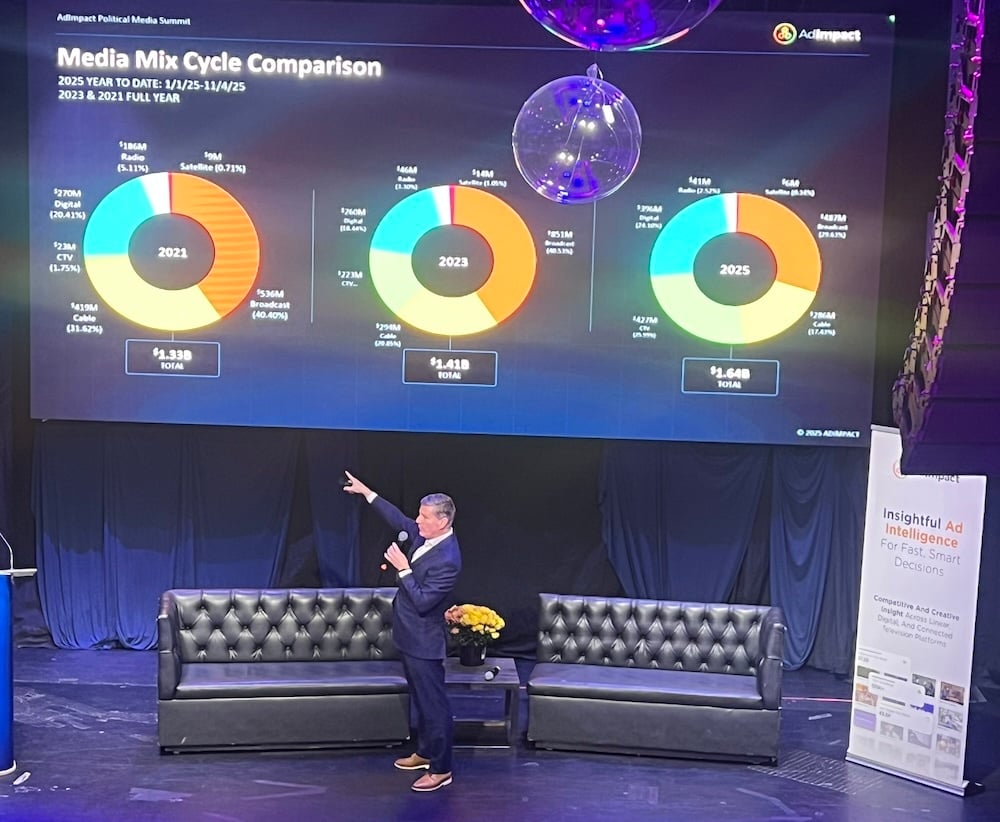The first quarter of the year consistently brings some of the most talked-about TV events, and Q1 2025 was no exception. From the Presidential Inauguration to the NFL Championship games and Super LIX to iconic award shows like the Golden Globes, Grammys, and Oscars, the first three months of the year were filled with major TV moments that captured the nation’s attention.
While linear TV remains the dominant viewing platform for these events, streaming is on the rise each year, especially for the Super Bowl. In an inaugural quarterly television insights report, AdImpact takes a closer look at the viewership data, ad airings and advertising trends of these marquee moments – and what marketers need to know to fine-tune their strategies.
Inauguration Rings in New Administration
The 2025 Presidential Inauguration of Donald J. Trump on January 20 was simulcast across various networks, with peak viewership reaching 56.3 million viewers at 12:04 pm ET, coinciding with the moment that President-elect Trump was sworn in. The average viewership throughout the event was 40 million viewers.  Linear viewing was 54% of the total, with other streaming platforms accounting for 29% and YouTube and YouTubeTV accounting for 17%. Other streaming platforms encompass TV native apps (e.g., apps directly on Smart TVs) and OTT streaming devices (e.g. Roku or Amazon Fire Stick).
Linear viewing was 54% of the total, with other streaming platforms accounting for 29% and YouTube and YouTubeTV accounting for 17%. Other streaming platforms encompass TV native apps (e.g., apps directly on Smart TVs) and OTT streaming devices (e.g. Roku or Amazon Fire Stick).
Fox News Channel was the most watched network, with 21% of all linear viewers. NBC and CBS were right behind at 18% and 17%, respectively. ABC came in fourth, accounting for 16% of linear viewers.
 NFC East Matchup Leads to Viewership Drop in NFC Championship
NFC East Matchup Leads to Viewership Drop in NFC Championship
The 2025 NFC Championship Game between the Washington Commanders and Philadelphia Eagles was broadcast on Fox and across various streaming platforms, including Fubo, DirecTV and NFL+.  Peak viewership reached 78.6 million viewers at 5:47 pm ET, while the average viewership was 59.8 million viewers. Both peak and average viewership numbers were down from the 2024 NFC Championship between the San Francisco 49ers and the Detroit Lions. In 2024, peak viewership was 79 million viewers, while average viewership was 72.9 million.
Peak viewership reached 78.6 million viewers at 5:47 pm ET, while the average viewership was 59.8 million viewers. Both peak and average viewership numbers were down from the 2024 NFC Championship between the San Francisco 49ers and the Detroit Lions. In 2024, peak viewership was 79 million viewers, while average viewership was 72.9 million.
Linear viewing accounted for 58% of the total viewership, showing no change from last year, while streaming made up 42%. YouTube and YouTubeTV’s share increased by 4% to reach a total of 19% this year, shifting some audience from other streaming platforms.
It’s likely the drop in viewership was due to this year’s game being a blowout, while the game between the Lions and the 49ers was a close one until the end. The increase in streaming suggests that consumers are becoming more comfortable with watching live sports on streaming over linear.
Super Bowl Ratings Are Super Despite Blowout
Super Bowl LIX between the Kansas City Chiefs and the Philadelphia Eagles aired on Fox, its free streaming service Tubi and Fox Deportes, which carried the Spanish language feed. Peak viewership hit 152.4 million viewers at 8:16 pm ET, just before halftime, with an average of 137.7 million- both breaking previous records.  Last year’s Super Bowl between the Kansas City Chiefs and the San Francisco 49ers saw an average viewership of 109.4 million and a peak viewership of 115.5 million.
Last year’s Super Bowl between the Kansas City Chiefs and the San Francisco 49ers saw an average viewership of 109.4 million and a peak viewership of 115.5 million.
Fox accounted for 41% of all viewers, while Fox Deportes accounted for 10% of all viewership. Tubi made up 18.7% of the audience, followed by other streaming platforms at 17.4% and YouTube/YouTubeTV with 12.8%.
Linear was down from last year’s Super Bowl, which accounted for 58.5% of the audience. Other streaming made up 27.7% and YouTube/YouTubeTV made up 13.8%.
Given the blowout nature of the game, it's no surprise that Kansas had the highest change in viewership relative to market size at the Super Bowl at 12.4%. West Virginia (-12.2%), Wyoming (-11.9%) and Ohio (-11%) had the next highest declines in viewership.
On the other hand, California had the lowest drop in viewership from the beginning of the game to the end at 4.4%. West Coast states Nevada (-4.5%), Hawaii (-4.8%) and Oregon (-6.2%) had the next lowest drop. Unsurprisingly, Pennsylvania had the fifth lowest drop, at -6.3% as Eagles fans celebrated their victory.
 The decision to air the Super Bowl for free on streaming for the first time paid off for Fox as Tubi had the highest share of all streaming platforms. It’s likely other broadcasters will offer the Super Bowl for free on their own streaming platforms in the future as they hope to mirror Fox’s big win. Read the full analysis here.
The decision to air the Super Bowl for free on streaming for the first time paid off for Fox as Tubi had the highest share of all streaming platforms. It’s likely other broadcasters will offer the Super Bowl for free on their own streaming platforms in the future as they hope to mirror Fox’s big win. Read the full analysis here.
We’re Just Here for the Super Bowl Ads
When it comes to the main event for the advertising industry and many consumers – the Super Bowl ads – beer brands and movies had the most amount of airings among all categories observed, with five each. Budweiser, Michelob Ultra, Stella Artois, Bud Light and Coors were the brands that advertised during this year’s game. Thunderbolts, Lilo & Stitch, How to Train Your Dragon, Mission: Impossible- The Final Reckoning and MEGAN 2.0 were the movies that ran ads this year.
Budweiser, Michelob Ultra, Stella Artois, Bud Light and Coors were the brands that advertised during this year’s game. Thunderbolts, Lilo & Stitch, How to Train Your Dragon, Mission: Impossible- The Final Reckoning and MEGAN 2.0 were the movies that ran ads this year.
Despite having the highest number of ads this year, both categories were down from 2023, where each category aired nine ads.
Streaming platforms had the next highest number of ads, with four, as Tubi, Fox, Disney and YouTube showcased their streaming offerings. Streaming advertisements were also down from previous years, as 2023 saw five streaming ads and 2024 saw seven.
The QSR category was the only one that saw an increase from previous years, going from one ad in 2023 and two in 2024 to three in 2025. Dunkin, Little Caesar’s and Taco Bell all aired national ads during the 2025 Super Bowl.
Lastly, sports betting ads maintained their 2024 output, with two ads aired from FanDuel and DraftKings.
This category breakdown shows that traditional Super Bowl advertisers like beer brands and movies continue to dominate the landscape, but they have seen challenges in maintaining the heights seen in previous years. As such, there is room for newer categories like streaming platforms and sports betting to become a staple during future Super Bowl games. Read the full Super Bowl LIX ads analysis here.
Award Shows Bring Home the Trophies
The 97th Academy Awards on March 2 were broadcast live on ABC stations. Various streaming services showing the awards presentation included Hulu, YouTubeTV and FuboTV.
Peak viewership hit 20.6 million viewers at 9:03 pm ET, with an average of 17.8 million people tuned in. Viewership was heavily skewed towards linear, accounting for 64.4% of the audience, followed by YouTube/YouTubeTV at 19.4% and other streaming platforms making up 16.2% of the viewership.
The 67th Grammys on February 2 saw similar viewership numbers, with a peak of 20.5 million and an average of 17.6 million. Both figures, however, were down from 2024, where peak and average viewership were 20.7 million and 18 million, respectively. Linear accounted for 65% of the audience.
The 82nd Golden Globes, which were broadcast on CBS and Paramount+ on January 5, saw the lowest amount of viewership, with an average of 10.1 million viewers and a peak of 13.5 million viewers. This year’s peak was up from 12.4 million in 2024, but the average was down slightly, falling from 10.2 million to 10.1 million. Linear dominated viewership with a 68.4% share, followed by YouTube/YouTubeTV at 16.7%, showing award shows are primarily a linear event.
 Awards Show Advertisements Stay Steady in 2025
Awards Show Advertisements Stay Steady in 2025
The television stations presenting each award show had the highest amount of ad airings, with ABC getting 37 ad airings on the Oscars and CBS getting 42 on the Golden Globes and 25 on the Grammys. Paramount+ also had the second most airings on the Golden Globes and Grammys, with 23 airings each. McDonald’s had the second most airings on the Oscars with 15.
Ad airings this year mirror similar trends seen during last year’s events, as the television presenter for the Oscars and Golden Globes had the most amount of ad airings. Like 2025, ABC aired the Oscars, while CBS aired the Golden Globes in 2024. The only notable difference was for the Grammys, where McDonald’s had the most airings, at 16, followed by Toyota with 15 airings.
Overall, legal services was the category with the highest number of airings on each awards show in 2025. Fast food was the second most popular category on the Oscars and Grammys, while furniture was the second most popular category on the Golden Globes. These trends again mirror what was seen in 2024, with the only difference being automotive taking the second spot during the Oscars and station promotions taking the second spot for the Golden Globes.
A Record-breaking Judicial Race in Wisconsin
The Wisconsin State Supreme Court race set a new precedent, becoming the most expensive judicial election to date. A staggering $67.1 million was spent on advertising, surpassing the previous record by $27 million. Notably, 44% of this expenditure came from outside groups, with significant contributions from figures like Elon Musk. The dominant themes in these advertisements were crime and abortion, underscoring the pivotal issues influencing voter sentiment. Read the full analysis here.
 What This Means for You
What This Means for You
Tentpole television events are still the biggest viewership drivers, generating significant interest across linear and streaming platforms. The breadth of advertisers and categories investing in campaigns around these events signals that they still matter in the television landscape.
However, the budgets needed for campaigns on these events aren’t possible for every brand, especially when a Super Bowl ad is going for $8 million.
Instead, advertisers can look to buy regional spots to reach the same audience for a smaller cost. Local advertisements can help smaller brands extend their reach and maximize their budget, while also providing a more targeted message.
Additionally, advertisers should consider their target audience when investing in major television events. For instance, the majority of Oscars viewership was via linear, while the Super Bowl saw linear’s share account for only 51% of all viewers. Linear audiences tend to be older, while streaming viewers tend to be younger, so brands looking to target older audiences should invest more dollars into linear.
Overall, advertisers need to determine the objectives of their campaign, the audience they want to reach and their budget. Following that, they can identify the best path forward for advertising around major television events.
Stay tuned for next quarter’s report where we’ll look at March Madness, women’s sports, F1 Miami, the Masters and Marvel movie trailers.
METHODOLOGY
All viewership data is generated from data collected through AdImpact’s Advanced TV panel of monitored Smart TVs, totaling 23 million TVs. This data includes viewing patterns and devices tracked using automated content recognition (ACR) technology.
The distinction between linear and non-linear content is based on whether it’s viewed via a set-top box, direct cable connection, or antenna (linear) or through a TV native app or OTT streaming device (non-linear). This data specifically focuses on live programming for the event and excludes non-live content.










